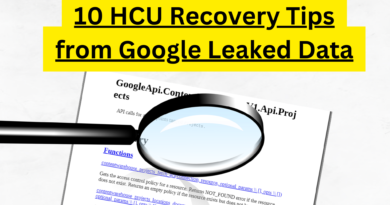How to Structure Content for AI Visibility with Rank Math
Search is changing. It’s no longer only about Google’s 10 blue links. Today, AI systems like Google Gemini, ChatGPT, and Perplexity are pulling answers directly from websites. If your content isn’t structured the right way, these AI tools may skip over it.
The good news is that WordPress users don’t need to stress. Rank Math has already introduced features that help you prepare your site for AI visibility. From schema to Content AI, and even tracking AI Search Traffic inside Analytics, the plugin makes it much easier to stay ahead.
In this guide, I’ll show you how to structure your content step by step and how Rank Math can help you take advantage of this AI-first world.

Why AI Visibility Matters in 2025
Let me tell you why this is very important.
When people search on Google now, they don’t always scroll down to see the 10 links. Instead, they read the AI Overview box at the top. That overview is generated from different websites. If your content is structured well, your site can be picked as a source. If it is not, you will miss out.
It is the same story with AI tools like ChatGPT and Perplexity. These tools are pulling content from different websites, summarizing it, and showing it to their users. They sometimes link back to the source. If your site is included, you get referral traffic.
That is why AI visibility is now part of SEO.
That said, the game doesn’t end just by securing the #1 spot on search. We are now required to consider AI visibility because it’s part of the game.
Rank Math has recognized this trend. That is why they added new features like LLMs.txt (to control how large language models crawl your site) and AI traffic insights (found in the Analytics tab). With these tools, we can position our websites for the future of search.
Core Principles of Structuring for AI Visibility
If you want AI assistants to pick your content, there are some simple but powerful principles you need to follow.
1. Use clear Headings (H1, H2, H3)
AI tools read content almost like humans, but they depend more on structure. If your headings are unclear, poorly written, or don’t include your main keyword, AI may not fully understand your content.
So always use a clear, keyword-rich H1 for your main topic. Then break your content into sections with H2s. Use H3s for the smaller points under each section.
2. Answer Questions directly
AI loves short and clear answers.
If someone searches “Best AI WordPress Plugins?” and your post answers it in the first two lines, AI is more likely to use your site.
3. Use FAQ-style content
Many AI assistants pick from FAQ schema. When you add FAQs to your post, you increase the chance of being quoted by AI.
But there’s something you should note. In August 2023, Google reduced support for FAQ rich results. The expandable FAQ boxes you used to see in search are now shown mainly for government and health websites. For many sites, they no longer appear often.
This does not mean FAQ schema is useless. It is still valid structured data that helps Google and AI systems understand your content better. Rank Math also allows you to easily add FAQ schema to your posts through its Schema settings or blocks.
So it’s still worth including FAQs as far as they add value. Just don’t expect that Google will always display them as rich snippets. The bigger advantage now is that your content becomes clearer for AI assistants and search engines. And that improves your chance of being picked in AI overviews.
4. Write in concise paragraphs
Avoid long blocks of text. AI tools prefer short paragraphs. It makes it easier to extract the right information.
You should also try to provide the needed information or answer the question ASAP. You can use hacks like TL:DR to help AI scrapers and users.
5. Add Schema Markup
Schema tells both Google and AI what your content is about. FAQ schema, HowTo schema, and Product schema are very powerful. Without schema, AI may misinterpret your content.
How Rank Math Helps
Now let’s bring Rank Math into the picture. This plugin is not just for title tags and meta descriptions. It is already ahead when it comes to AI visibility.
The plugin currently has two features (that helps structure your content for AI visibility) — structured data for LLMs, and AI traffic under Analytics.
1. Schema Generator
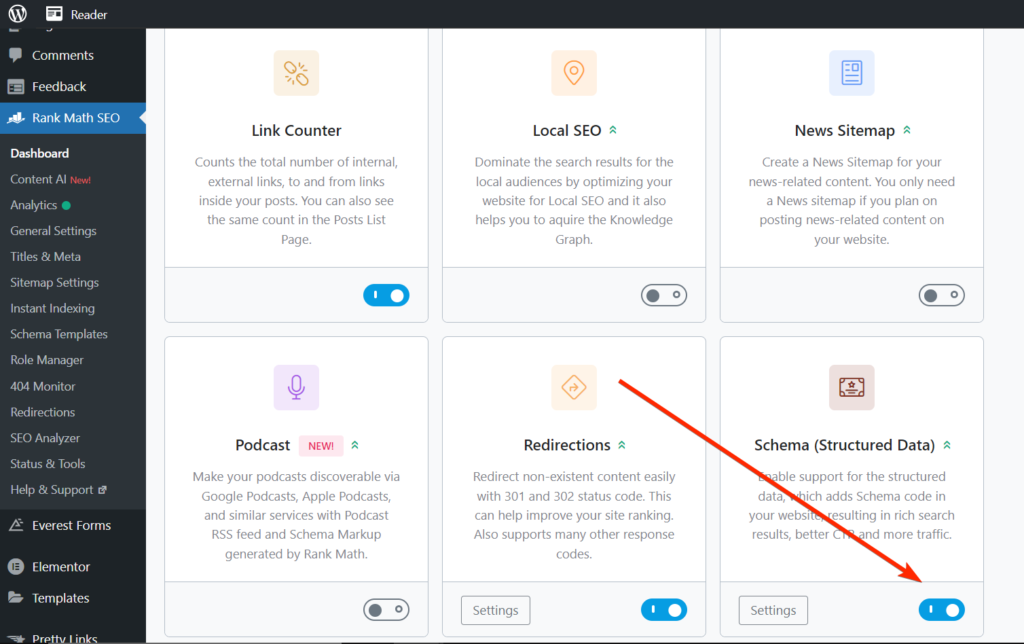
With Rank Math, you can add schema without writing code.
It has options for FAQ, HowTo, Product, Local, and many more. That means you can structure your post for AI in just a few clicks.
In fact, the plugin is one of the best schema mark-up tools for WordPress.
2. Content AI
This is one of the best features.
Content AI helps you find keywords, related entities, and even questions people ask. You can use these suggestions to create content that AI assistants will find useful.
Another part of Content AI contains a plethora of content writing blocks that speeds up article production.
I like the paragraph rewriter (which lets me polish a vague sentence), the blog post introduction block and the conclusion block—they haven taken over those parts.
Some other amazing Content AI blocks include the sentence expander, fix grammar, and the text summarizer.
We now have the power of GenAI right on WordPress. No more copy-pasting your AI-assisted article from let’s say ChatGPT to your website.
3. Analytics and AI Traffic
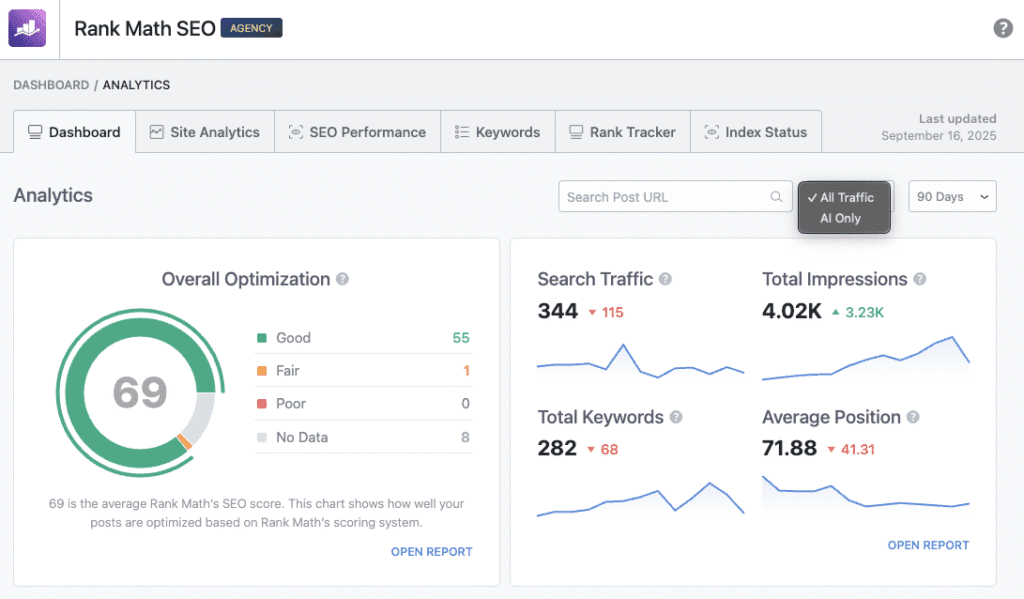
Rank Math Analytics connects with Google Analytics and Search Console.
Recently, they introduced filters for AI traffic. That means you can check if your content is getting visits from AI platforms.
4. LLMs.txt (New)
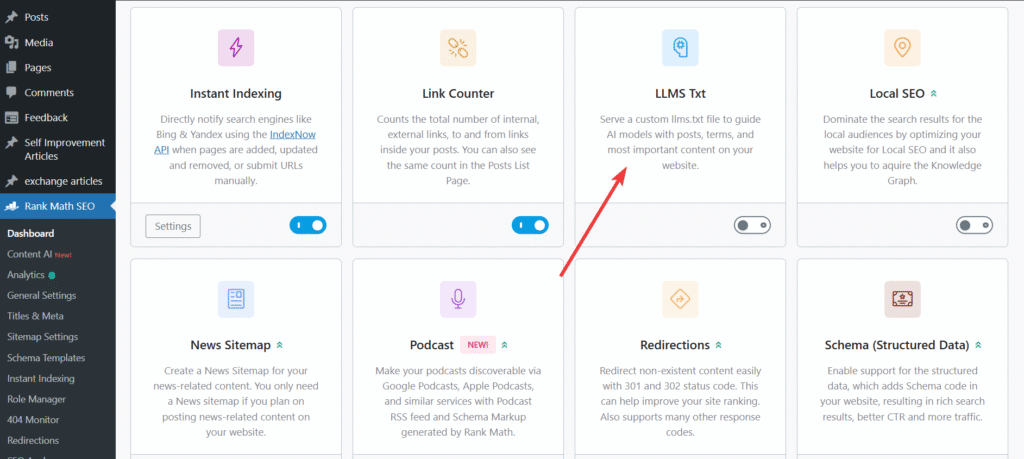
This is another big one.
Just like robots.txt controls how search engines crawl your site, LLMs.txt controls how large language models (like OpenAI or Anthropic) can crawl and use your content.
With Rank Math, you can generate and manage this file easily.
The LLMs.txt lets AI scrapers know the most important pages on your website and to give them the visibility they deserve.
Step-by-Step Tutorial on optimizing for AI visibility
Let us now move from theory to action. This is how you can set up your content for AI visibility using Rank Math, step by step.
Step 1: Install and Set Up Rank Math
The first step is simple. Go to your WordPress dashboard. Click Plugins → Add New, then search for Rank Math SEO. Install it and activate it.
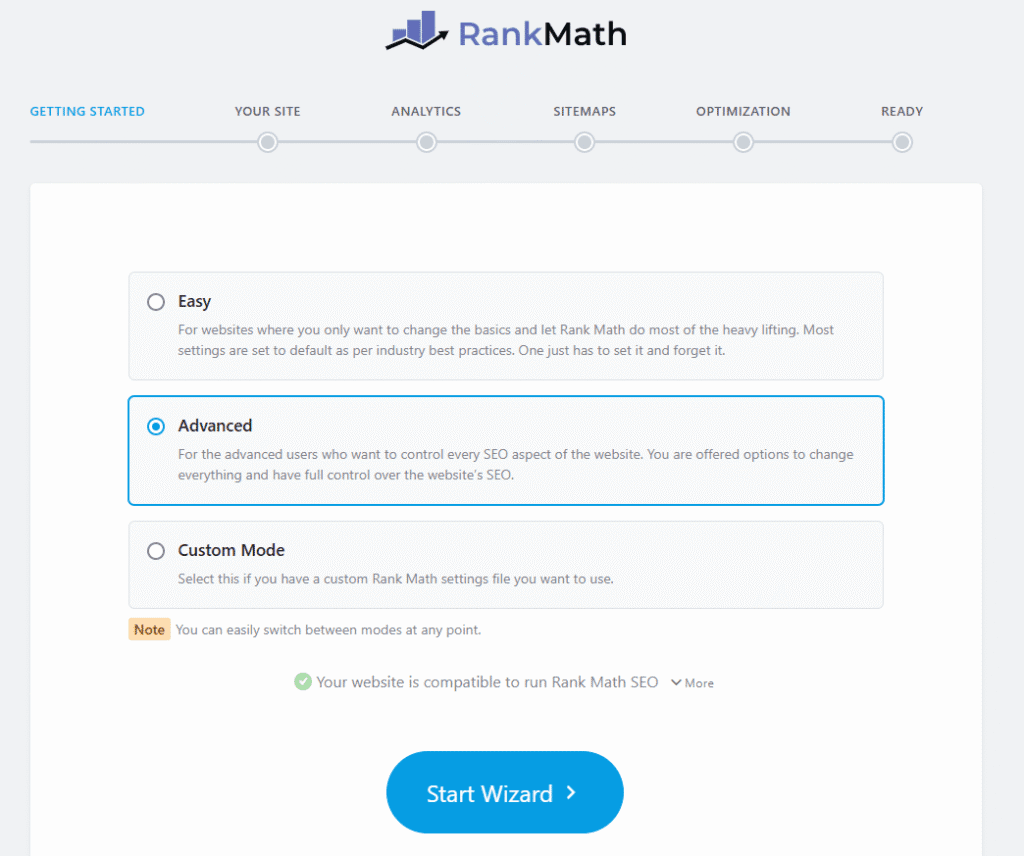
Once it is active, Rank Math will show you a Setup Wizard. Please don’t skip it.
The wizard helps you connect your site to Google Analytics, Google Search Console, and also sets up your sitemap automatically.
If you are serious about AI visibility, make sure you connect to both Analytics and Search Console.

The reason is this — The plugin uses the connection to show you how your site is performing, including traffic sources from search engines or large language models.
This setup only takes a few minutes. After that, Rank Math is ready on your site.
Step 2: Use Content AI for Research
Now that Rank Math is active, it is time to use the research ability of Content AI.
Open the post editor in WordPress. On the right-hand side where Rank Math options appear, you will see Content AI. Go to “Tools > Topic Research”.
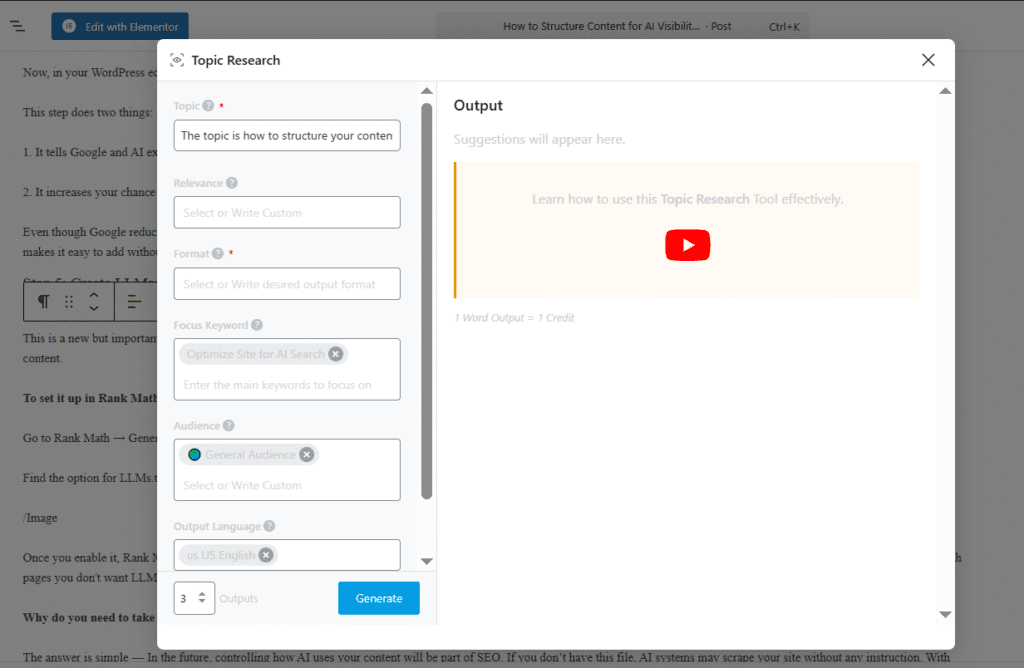
Then fill all the sections. Rank Math content AI will do the research for you and provide you with the information you need.
As you make progress in your article writing, you can always use the topic research tool. It allows you to take a deep dive into any subject and explore subtopics you may not know much about. With this tool handy, the articles you produce will always be top-notch.
!Important: Rank Math also helps you generate an outline with ease. It not only saves you time but also prepares your content for better AI visibility.
Step 3: Structure Your Post with Headings
Now it’s time to write. As I said earlier, structure matters a lot for AI. Don’t just write one long essay.
Start with your H1 heading — this should contain your main keyword. For example: Best AI Affiliate Tools.
Then, use H2s to break your content into clear sections. For instance:
- Why AI tools are important for affiliate marketers.
- Best AI affiliate tools you can use today.
- Free vs. paid AI tools — which one should you choose?
- How to pick the right AI tool for your affiliate business.
Inside those H2s, if you need smaller points, use H3s. Example: under “Best AI affiliate tools you can use today,” you can break it down with H3s like:
- Content creation tools.
- SEO optimization tools.
- Analytics and tracking tools.
This structure is not only good for readers, it also helps AI systems. When an AI assistant scans your post, it can easily understand what each section covers and pull the right answer.
Step 4: Add FAQ Schema
After you write your post, add a section for Frequently Asked Questions (FAQs). You don’t need to overdo it. Three to five questions are enough.
Example FAQs for a “Best AI Affiliate Tools” article:
- What are the best free AI tools for affiliate marketing?
- Do I really need paid AI tools as a beginner affiliate?
- Which AI tools help with SEO and content optimization?
- Can AI tools replace human effort in affiliate marketing?
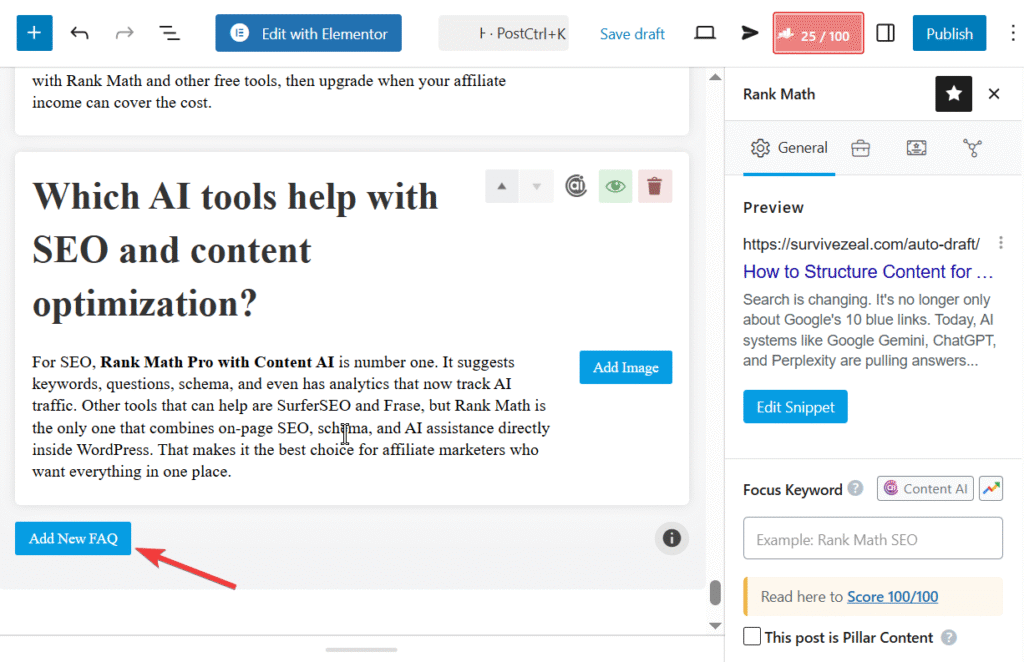
Now, in your WordPress editor, scroll down to the Rank Math → Schema section. Select FAQ schema and add your questions with short, clear answers.
This step does two things:
- It tells Google and AI exactly what your FAQ section is about.
- It increases your chance of being used in AI answers.
Even though Google reduced FAQ rich results in 2023, FAQ schema is still valuable. It improves how search engines and AI systems understand your site. And the best part? Rank Math makes it easy to add without touching code.
Step 5: Create LLMs.txt
This is a new but important step. Just like robots.txt controls how search engines crawl your site, LLMs.txt controls how large language models (like ChatGPT or Claude) can use your content.
To set it up in Rank Math:

Go to Rank Math → Dashboard.
Find the option for LLMs.txt and enable it.
Once you enable it, Rank Math will generate an LLMs.txt file automatically for your site. You can then select which post types should be included as well as taxonomies. RankMath also allows you to set limits for the number of links to include for each post type. In the additional content bar, you can add extra text or links that you want to include in your llms.txt file.

Why do you need to take this step?
The answer is simple — In the future, controlling how AI uses your content will be part of SEO. If you don’t have this file, AI systems may scrape your site without any instruction. With Rank Math, you are in control.
Having an LLMs.txt file is a way to signal AI crawlers about the key pages of your site you want them to notice.
Step 6: Monitor AI Traffic in Analytics
Finally, let us track results.
Go to Rank Math → Analytics in your dashboard. Here, you can see traffic from Google, Bing, and even AI platforms (if they send referral traffic). There is a filter where you can check “AI Only” traffic.
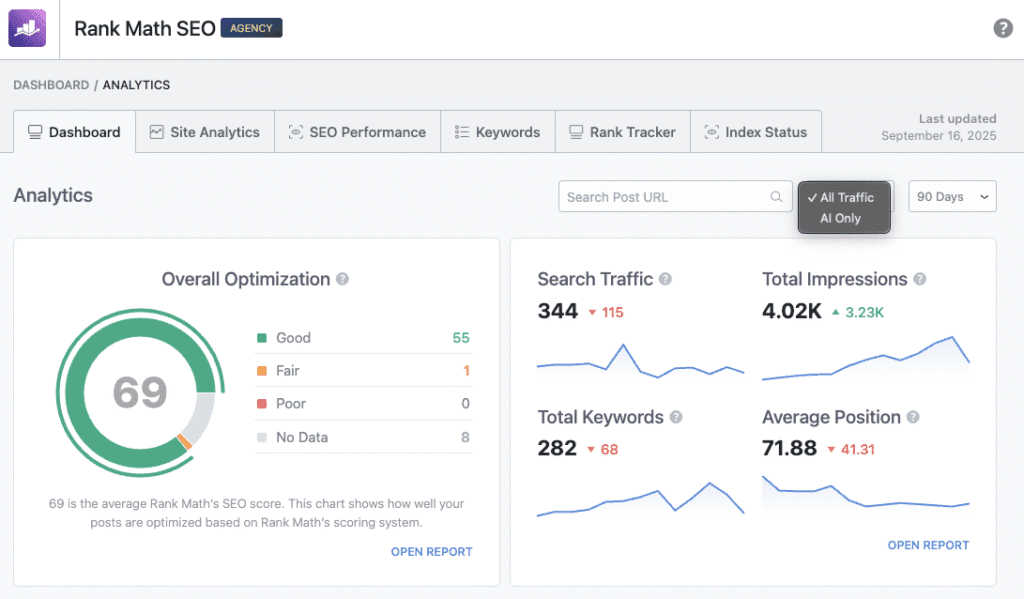
Now, let me be real with you: if your site is small (like under 1,000 visitors per month), you may not see AI traffic immediately. That’s normal. But by preparing your content with the steps above, you are laying the foundation. As AI-driven search grows, your site will already be structured for it.
Conclusion
AI is not replacing search, but it is reshaping it. If you want your website to remain visible, you need to structure your content in a way that AI can easily read and use.
Rank Math makes this simple. From Content AI to schema generator, LLMs.txt, and AI traffic analytics, the plugin gives you everything in one place.
So don’t wait until AI takes over your traffic. Start today.
👉 Get Rank Math Pro here and unlock the full power of Content AI and Analytics.
FAQs
Why do I need AI visibility in SEO?
Because AI assistants are now giving answers directly to users. If your site is not picked up, you lose visibility.
Does Rank Math really help with AI traffic?
Yes. Rank Math provides schema, LLMs.txt, Content AI, and Analytics that support AI-driven visibility.
Is AI visibility the future of SEO?
Yes. Traditional SEO is still important, but AI visibility is the next stage.

